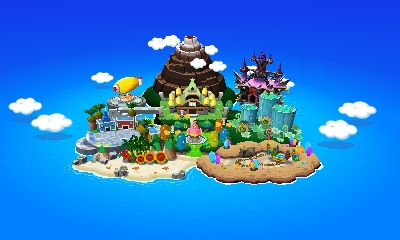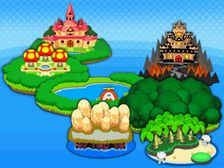Mario and Luigi: Dream Team Bros. – Table Design Meets Overworld Design
April 28th, 2018
Mario and Luigi: Dream Team Bros.‘s hub-based overworld design and Bowser’s Inside Story‘s organic overworld design function much like the circular dining tables of Chinese culture and the rectangular dining tables of Western culture.
Round tables symbolise collectivist ideology where all participants are equal. Each member sits equal distance apart and is therefore able to see everyone else at the table and easily participate in group discussion. With Dream Team Bros.‘s hub-based map design, each area is equal distance apart and requires roughly the same amount of play time to complete. Players can easily navigate between areas through the centre point (engage in the main conversation) or move between adjacent areas (converse with the person next to them). Since everything is orientated around a centre, the design minimises the amount of backtracking (private conversation).
Rectangular tables contain a head and a foot for those individuals of distinction. Similarly, Bowser’s Inside Story‘s worlds of varying shapes and sizes fit within the confines of a rectangular box. The access to different areas of the map is therefore uneven much in the same way that someone on one side of a rectangular table might struggle to speak to someone on the other side. The design favours those who sit in the middle of the table and are able to navigate between conversations on either sides. Meanwhile the corners remain isolated. Usually, if someone wishes to talk to a person outside of clear speaking distance, they’ll move or switch chairs at some point later in the meal. Similarly, as the player progresses through BIS, they’ll discover the underground train network known as Project K which allow them to fast travel across the map.
What I like about games like BIS is how this unevenness in the overworld design characterises the play experience. Dimble Woods and Blubble Lake are frequent junctions, sharing the centre area of the map. You pass through these areas multiple times and they have multiple entry and exit points. Toad Town joins Blubble Lake and Peach’s Castle, while Plack Beach archs around between Dimble Woods and Cavi Cape. Both areas act as a sub-juncture. Bumpsy Plains is a small join between areas. The remaining locales dwell on the outskirts and naturally take longer to reach. To further complicate the relationship between these areas, the Project K railroad links the fringes in a circle. The uneven jigsaw of worlds gives each area a personality pertinent its relative positioning and functional role within the geography. The dynamics of space and mobility play out much like the social dynamics governing where we choose to sit and who we choose to sit next to at a rectangular table.
In terms of its impact on the experience, the design of a table doesn’t differ much from the design of an overworld in a video game. These analogies work because the dynamics of space and mobility are universal.
Mario and Luigi: Dream Team Bros. – Defining Gameplay Progression Across the Series
April 25th, 2018
The best way I could summarise Mario and Luigi: Dream Team Bros‘s gameplay progression would be to say that it’s a hybrid of Partners in Time and Bowser’s Inside Story. In PiT, the player enters each major area through warps points littered throughout Princess Peach’s Castle. With each locale being standalone, once the Bros. complete one area, they can move onto the next. In BIS, the player criss crosses a large interconnected map Metroidvania style and unlocks new environments as they gradually acquire new abilities. DTB features both the segregated areas of PiT and folded design of BIS.
Once the player has completed Dream Team Bros.‘s opening tutorial, they work their way around the game’s hub, tackling one locale at a time (as with PiT). Each area contains an overworld section set in an isometric perspective and a dream world section set in the sidescrolling perspective. (Resident commenter and friend of the blog Cheatmaster30 describes the dream world as being Mario and Luigi’s equivalent to a Zelda dungeon). Later, after Princess Peach is captured, the Bros must complete a scavenger hunt to collect the various zee parts of the Ultibed. The game progression then shifts from a linear to a freer format where the player can revisit the previous five locations in any order they choose (folding over prior areas like BIS). Finally, after a short interlude where the Bros meet up with Bedsmith, the player must tackle Somnom Woods and Dreamy Neo Bowser’s Castle in the lead up to the finale.
AlphaDream also integrated various side events into Dream Team Bros.‘s story to allow the player to shape their progression through the game. These optional extras come in the form of Pillos, anthropomorphic head rests which act as portals into Luigi’s dreams. Each excursion into the dream world offers additional challenges and rewards which can assist the player in the main game.
Dream Team Bros. and Bowser’s Inside Story differ in how they organise the flow of gameplay, how this organisation can be read through the game world, and how the player can choose to deviate from the main story. These two approaches to game progression give each game a distinct feel.
After some lead-in, Dream Team Bros. falls into a comfortable rhythm of overworld-to-dreamworld, locale-to-locale gameplay where the player has the option of taking minor deviations if they wish. This model is highly explicit. With each area requiring a roughly similar time investment, the player can read their game progress by simply looking at the world map and noting the number of worlds they have completed. Along the same lines, Pillos clearly signpost additional content, dream world challenges which are themselves wholly separated from the overworld. Each major area on the world map stands by itself as well, with minimal bleeding into adjacent zones. The clear cut and explicit nature of the game world establishes clear expectations for how the adventure will play out, although some players may find this approach to be somewhat artificial.
In BIS, the progression of gameplay isn’t quite as explicit. AlphaDream organised the game’s story around the Bros. and Bowser much in the same way as DTB is organised around the overworld and dream world, but the size of each chapter of gameplay (usually the length of time the player spends as either avatar) varies significantly more than it does in DTB. And because the developers designed the interconnected worlds of the Mushroom Kingdom as a jigsaw and not as a hub lined with separate locales, the player doesn’t simply finish one level and move on. Rather, they visit the same junctures multiple times throughout the course of the story as needed. Many of the optional activities therefore emerge organically as the player passes through familiar areas with new abilities. These various elements give the experience a degree of inconsistency which can make the adventure seem to unfurl organically (even though it’s still tuned by the game developers).
Between Partners in Time, Bowser’s Inside Story, and Dream Team Bros., each title organises the Mario and Luigi adventure in a unique way (much like the Wario Land games). Partners in Time‘s adventure is heavily compartmentalised; Bowser’s Inside Story flows more organically; and Dream Team Bros. finds a comfortable midpoint between the two. When we pair these observations with the those from the prior article, we can see that with each iteration, the Mario and Luigi games evolve on multiple fronts.






 Game Design Companion: A Critical Analysis of Wario Land 4 - $7.99
Game Design Companion: A Critical Analysis of Wario Land 4 - $7.99 Level Design: Processes and Experiences
Level Design: Processes and Experiences Speed Boost: The Hidden Secrets Behind Arcade Racing Design - $5.99
Speed Boost: The Hidden Secrets Behind Arcade Racing Design - $5.99 Adventures in Games Analysis: Volume I - $5.99
Adventures in Games Analysis: Volume I - $5.99







